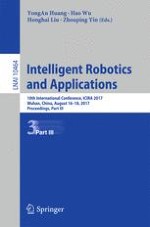2017 | Book
Intelligent Robotics and Applications
10th International Conference, ICIRA 2017, Wuhan, China, August 16–18, 2017, Proceedings, Part III
Editors: YongAn Huang, Hao Wu, Honghai Liu, Zhouping Yin
Publisher: Springer International Publishing
Book Series : Lecture Notes in Computer Science
